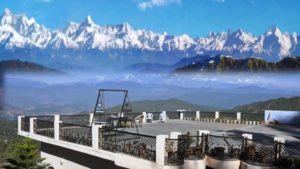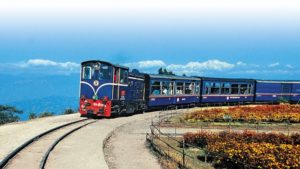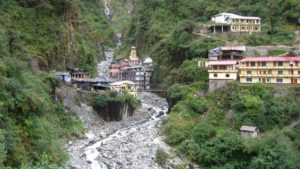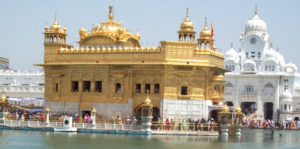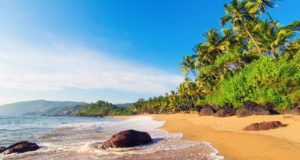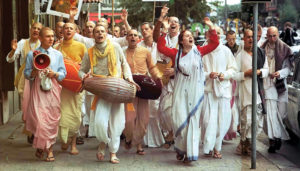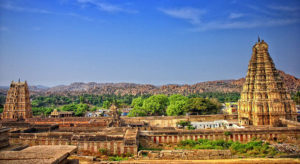By Swapan K Banerjee
When the Air India flight touched down at Devi Ahilyabai Holkar airport in Indore at around 2 pm, the temperature outside, the air-hostess announced, was 40+ degrees Celsius. Out of the airport in search of a cab for an hour’s journey to Ujjain, I just recoiled from the blistering heat. Would I be able to withstand this intense hot spell and have a good look around this holiest of holy place, hosting the Simhasth Kumbh Mahaparv 2016, I wondered.
From Shivansh Elegance at Hari Fatak Road, Nana Kheda, Ujjain, where I put up, one could see the evening sky on the Western horizon, raked with brilliant phosphorescent lights, charting the entire route of Kumbh Mela, skirted by river Shipra which now survives on borrowed water from the Narmada.
When I hit the road the next day, Ujjain was literally on the boil. Elderly men and women alike wore on their heads, a white scrap of cloth and milled about as if the weather was fine!
Jostling with the surging mass of people, I came into contact with Mr. Parmer, a Govt. teacher, and MIT student Rahul Sharma, manning one of the many roadside help-desks that dotted about the Kumbh campus. The size of the crowd would have been even higher but for the searing heat, they said. The sizeable chunk of the participants, the farmers, could not make it this time due to severe drought condition elsewhere in the state (MP).
Talking about Akhadas (organization of warrior monks) Rahul said: “These Akhadas hold their shows at Tower Chowk here in Ujjain a couple of weeks before the main event (almost like the drummers in Bengal before Durga Puja) to stake their claim in the hallowed Kumbh precinct. It’s a public show of how spiritually evolved they are.”
At this point, when I was about to venture out again into the fierce sun, K L Solanki, attached to MP tourism, offered me a ride on his scooter for a quick tour around the Ghats and Akhadas, which I gratefully accepted.
Down the Hari Fatak bridge crammed full of people we went, continually tooting on the horn, past the Patni Bazar, through Nayapura towards the Mangalnath zone via Gangaghat.
Among the four most sacred pilgrimage places in India, Solanki informed, “Ujjain has the largest area dedicated to this Maha-Mela. Around 15 Kms encircled by the river Shipra with turns and twists are home to temples like Mahakal, Harsiddhi, Char-Dham and many more open throughout the day and night during the Kumbh Mela.”
At first he took me to the tent of Sri Ramanand Community. Sri Sri Madhabacharji Maharaj was seated surrounded by his disciples blessing everyone. Our next stop Mounibaba ashram looked serene, like famed Mounibaba himself, who is close to 100 years now. Apart from the picturesque Ghat for bathing, it has an ageless Kalpa-Briksha (wish-fulfilling tree). When I asked the monk representing Mounibaba whether the tree could fulfill the wishes of each devotee, he said, “Certainly. Why don’t you try yourself”! I made a couple of wishes. Let’s wait and see…
Along the path to Mangalnath temple and then beyond it, Kal Bhairav temple and Bhartrihari Caves (where step brother of king Vikramaditya, king Bhartrihari (11th century AD) had retired after renouncing his complex conjugal ties, meditated and become a spiritualist), strange sights greeted my eyes. I saw a Sadhu standing on one leg, like a flamingo, deep in thought totally unaware of the hue and cry right in front.
Then there’re Sadhus sitting on makeshift swings with fire smouldering beneath. Solanki said: “These are not stunts. Spiritual development does not come easy. One has to endure bodily pain and rise above it. This is the only way to conquer death. These examples teach us never to forsake pain, but to embrace them.”
Those who do tapasya in remote places away from the public glare, do it here in Kumbh in full view of the public. The Tera Bhai Panch Group of Sadhus dug up a portion of earth allotted to them and sat there right out in the sun, unmoved. When I approached them for a brief chat, one of them badmouthed me. But Solanki managed to bring one of them out of the camp, who looked like a Bengali, shorn of any ill-feeling towards curious onlookers. Ram Dasaji, as known to the outside world, said: “Sadhus and saints have come here from the mountains, jungles and deserts. Our only purpose is to share with the seekers all the wisdom we have gathered over the years.” Before parting, he made a gesture for a little monetary help. I readily obliged.
We then reached Ram Ghat where shahi-snan was in full swing. It’s the place where the proverbial drop of nectar had supposedly landed. Despite having other wonderful riverside Ghats around modelled on Har Ki Pauri at Haridwar like Mangalnath Ghat, Ganga Ghat, Lal Pool Ghat, Triveni Ghat … people thronged here more than elsewhere. There’re boats lined up for merry-making. Fountain springs every 100 odd meters outside the reach of the bathers added sparkle to the show. Anil Bhatt from Hyderabad who I met at the Ghat looked very pleased with himself. “I came here”, said he, “at a moment’s notice. It’s totally unplanned. I feel so fulfilled that I could take a dip in this holy water. Although it stinks a bit.” But people in general had no qualms, whatsoever.
Next on my list was Dutt Akhada, where the Naga Sadhus concentrated. As I went up the steps and moved out of Ram Ghat, I saw a foreigner just ahead of me walking slowly in a thoughtful mood. I caught up with him. “I’m Suzuki from Japan”, he said.
Do you feel drawn to the Sadhus?
“In a way, yes. I’ve been to Allahabad and Haridwar. This is my third time. I keep reading the lives of Indian Sadhus particularly from the Himalaya who have achieved enlightenment. There’s something in the air at Kumbh that pacifies my troubled soul”. Suzuki then drifted away.
Dutt Akhada beckoned the wayfarers as if by an unseen hand. Tents pitched on both sides of this somewhat muddy thoroughfare running to mysterious bylanes housed Sadhus known for their aggressive posture and belligerent attitude. Most of them wore nothing, their bodies smeared with ash, some holding a trishul, and blessing the unsuspecting traveller in exchange for money. I came to a halt before a particular tent and took a snap of a Sadhu and was about to move away when I heard someone calling me. I ignored it and continued walking. But the call became louder and threatening. Not knowing exactly what to do, I turned around, fished out a crisp note out of my wallet and gave it to the terrified man standing nearby to hand it over to the angry Sadhu. I started walking again and no one called me back.
Out of Dutt Akhada, the sun sinking, my brief spiritual journey on its last leg, a foreign couple, the lady holding an expensive camera, came my way.
“We are from Germany, Thorge & Elice. Both of us are photo-journalists.”
Is this your first time at Kumbh, Elice?
“Yes, first time in India. Lovely people, so kind to us. From the top of the wagon in the procession we had a great view, made wonderful pictures and videos…”
And you, Thorge?
“Oh, this is my 4th time! I do not consider myself a very spiritual person, but I can sense the spirituality during a Kumbh Mela. It is one of the rare occasions where I feel the connection between every human being and myself, that we are all part of something greater. The whole event is impressively well organized and it touches me that within the days I spent here I got more smiles than in a whole year in Germany! My recommendation is: you have to experience this at least once in your lifetime!”
I was on my way back to the guest house. The pilgrims were streaming in non-stop from all directions, sitting now and then on their haunches at different crossing points under a tree. They had apparently nowhere to stay. But the hope of being blessed and washed clean of their sins, shone in their eyes. If there’s anything I came away with from the Kumbh Mela, it’s this resilience, the persistence to seek the grace of the Supreme against all odds.














